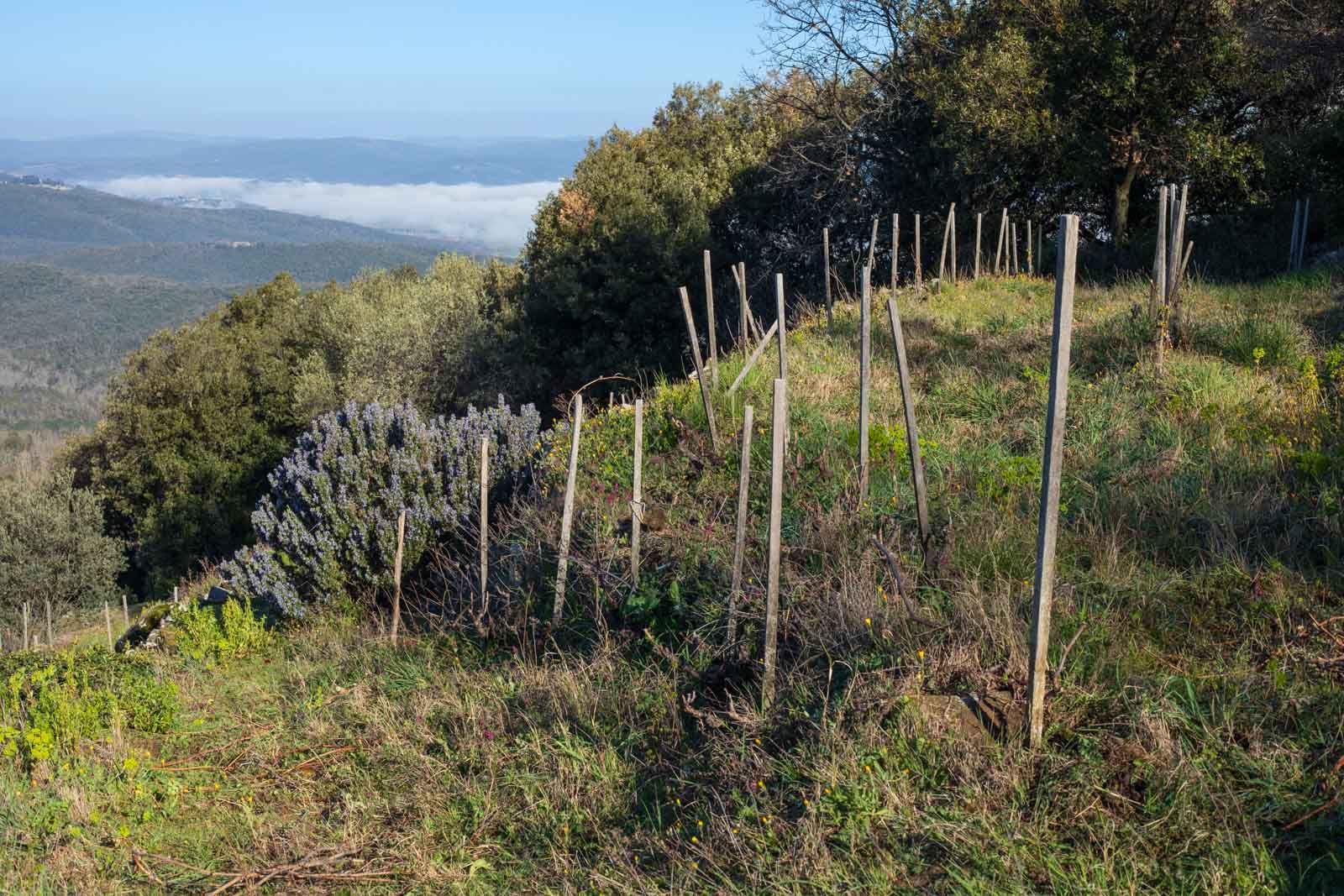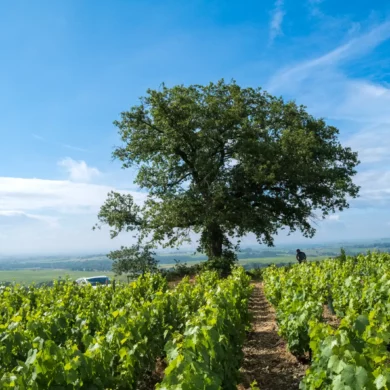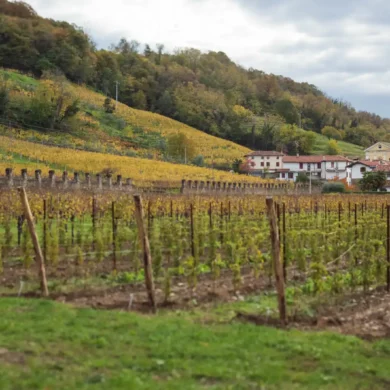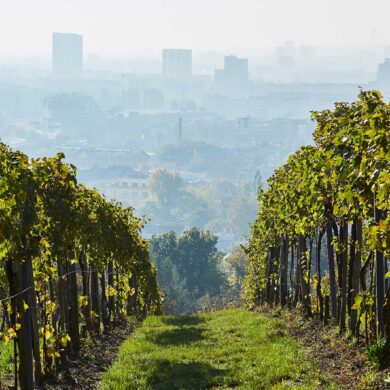The first thing to know about Francesco Mulinari’s L’Aietta vineyard is that you won’t find it on Google Maps. I should know, because that’s where I first looked for it. After Mulinari confirmed my April visit, I tried to triangulate his winery and vineyard’s location based on satellite imagery and what little has been written about him (most of which is from wine critic Kerin O’Keefe). My travel companion, Adam, and I were flying solo and under-the-radar in Brunello Land. This was vacation for him, so we were traveling without the aid of a local organization. But we had six appointments over two days, and I wasn’t about to let anything slide. I had been placing pins and calculating drive times, but with L’Aietta , I bumped into a hitch. You would think that a heroic vineyard on the backside of Montalcino’s imposing hill — with its dry-stone terraces and O’Keefe’s 98-point score — would at least be visible from space.
When I pointed out my struggles to Mulinari via email, he suggested that we meet in a parking lot off Via Aldo Moro below the town’s medieval fortress. He would lead us from there.
You would think that a heroic vineyard on the backside of Montalcino’s imposing hill would at least be visible from space.
“No problem,” he wrote.
When Adam and I arrived shortly after breakfast on a crisp but brilliant April morning, we found Mulinari standing alone in the completely empty parking lot. He was dressed with a double layer of jackets, and his blue cargo pants sported durable panels for his knees. He was clearly suited up for the toil of L’Aietta, but he also carried a pink shopping bag from the Montalcino co-op — which we later realized contained breadsticks for our tasting.
I looked around for his car. Nothing. He was on foot.
After brief introductions, Mulinari trotted ahead of our car while leading us down a nearby dirt road that pitched — no, plunged is more like it — into the woods. After a hundred yards or so, we arrived at a building, no larger than a detached garage. This was his winery. From here, it appeared, we would walk the remaining distance to the vineyard.
“Well, this is a new experience,” Adam deadpanned as we parked. The day before we had visited Biondi-Santi. Yes, this was very, very different.
“It Is My Love”
The walk was rocky, but short. As we popped out into a clearing, Mulinari welcomed us officially. “This is L’Aietta,” he said.
What greeted us was nothing short of spectacular, but I still had to squint to see the vines. There were no orderly wired rows or trellises, just a whole lot of grass and wildflowers and walls … and wooden stakes. Lots and lots of wooden stakes. At the base of each one grew a vine stub, pruned back for the dormant season. These were Brunello vines of a very different sort.
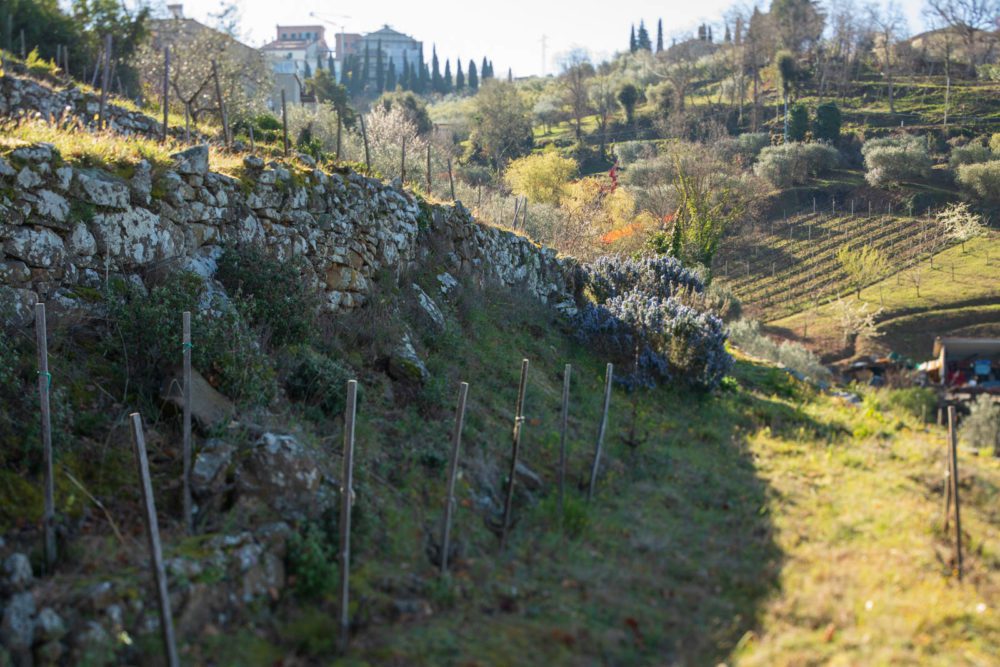
The story of L’Aietta defies much of Montalcino’s many narratives. As you approach the village from Siena, you will likely notice its ancient elegance way up there on the mountain that it crowns. But you will also see the spare-no-expense M.O. of its wine industry. Estates are framed by grand entryways, and the vines are as orderly and fawned over as they get. “Rustic” is the last word that comes to mind.
It is this context that makes L’Aietta feel like a hidden world — a bizarre secret garden in Tuscany’s most decorated appellation. And as Mulinari told me its story with his patient tempo and soft-spoken voice, it became clear that he and L’Aietta are as knitted together as the mossy stones holding up his terrace walls.
“I love this place,” he said. “It is my love.”
Mulinari’s family had purchased the plot not for wine or olives, but to host the family’s Sunday picnics. In 2001, while he was still finishing high school, Mulinari discovered that the old vines on the plot were registered with the Consorzio as Brunello — a distinct biotype of Sangiovese particular to Montalcino. There was no doubt, to him, what he wanted to do with the property.
The Wisdom of Alberello
In 2004, he planted more vines and chose to train them from the start as bush vines, known in Italy as alberello, or little tree. This was certainly not to please future wine geeks like me who were looking for a good story. He simply didn’t have space for any other option. Despite conventional wisdom at the time embracing a cordon-spur training system as the way for Sangiovese vines, Mulinari pursued a scrappier path — an ethos that has continued to this day.
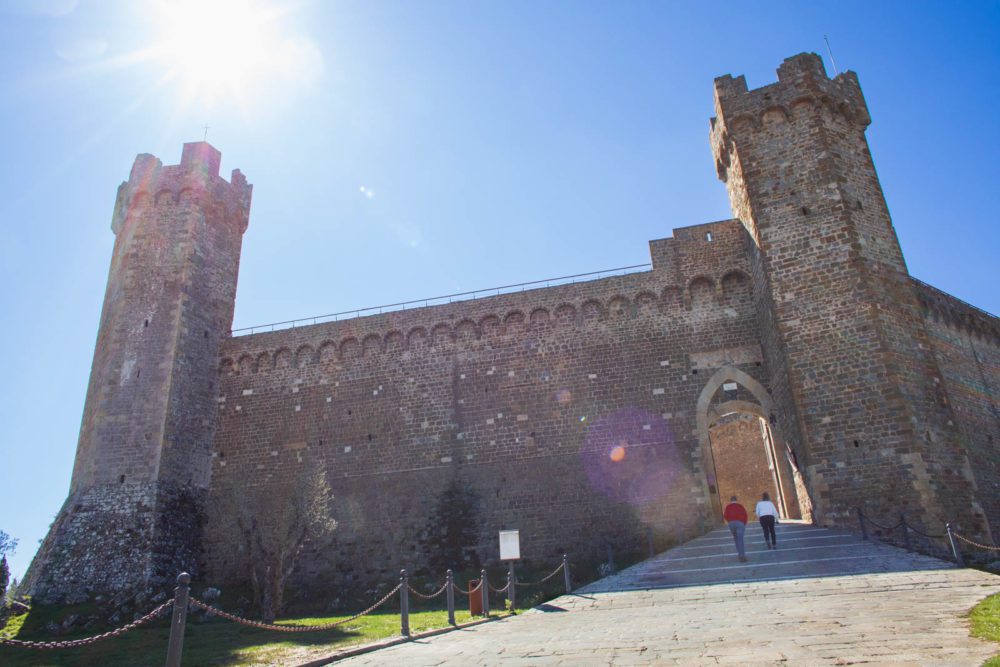
His decision is looking smarter and smarter these days, as the alberello vines are paying off in a way he had never imagined. With summers becoming increasingly hotter and drier, his vines are better equipped for drought. Alberello roots probe deeper, and their compact nature keeps vigor to a minimum, requiring less water for the portion above ground. L’Aietta’s soil is also sandy, so it does not hold on to water like clay does. As we walked around, the few bare patches of soil showed how quickly the overnight moisture had evaporated. Because of this, Mulinari has allowed grasses, herbs and flowers to grow in profusion, creating a natural carpet that hoards underground moisture during dry spells.
“If you go 10 centimeters down [underground], the soil is still cold because of this,” he told me.
In recent years, Montalcino has weathered significant dry spells and intense heat, but Mulinari has been surprised by how his vines have yielded little sign of stress, producing small-berried grapes that he has been pleased with.
I asked about his dry-stone walls, and whether their upkeep added to his labor hours each vintage. “No,” he said, as though the thought had never occurred to him. “These walls are very, very strong. They are five, six centuries old.”
The only time they had been damaged, he added, was when he brought a tractor in one time. Now, everything is done by hand or with the aid of a draft horse named Giorgia, who makes up to 40 different trips towing grapes out of L’Aietta to the small winery during harvest, as seen in this video below.
As I took photos of the vineyard, I made another discovery: resting in the morning sunlight at the foot of the vineyard was a red fox, her magnificent auburn coat glowing in the sunlight. Mulinari was thrilled to see her, noting that he knew of her presence but had not yet spotted her in the vineyard.
How had he known of her presence?
“She killed 10 of my geese,” he said without a trace of bitterness.
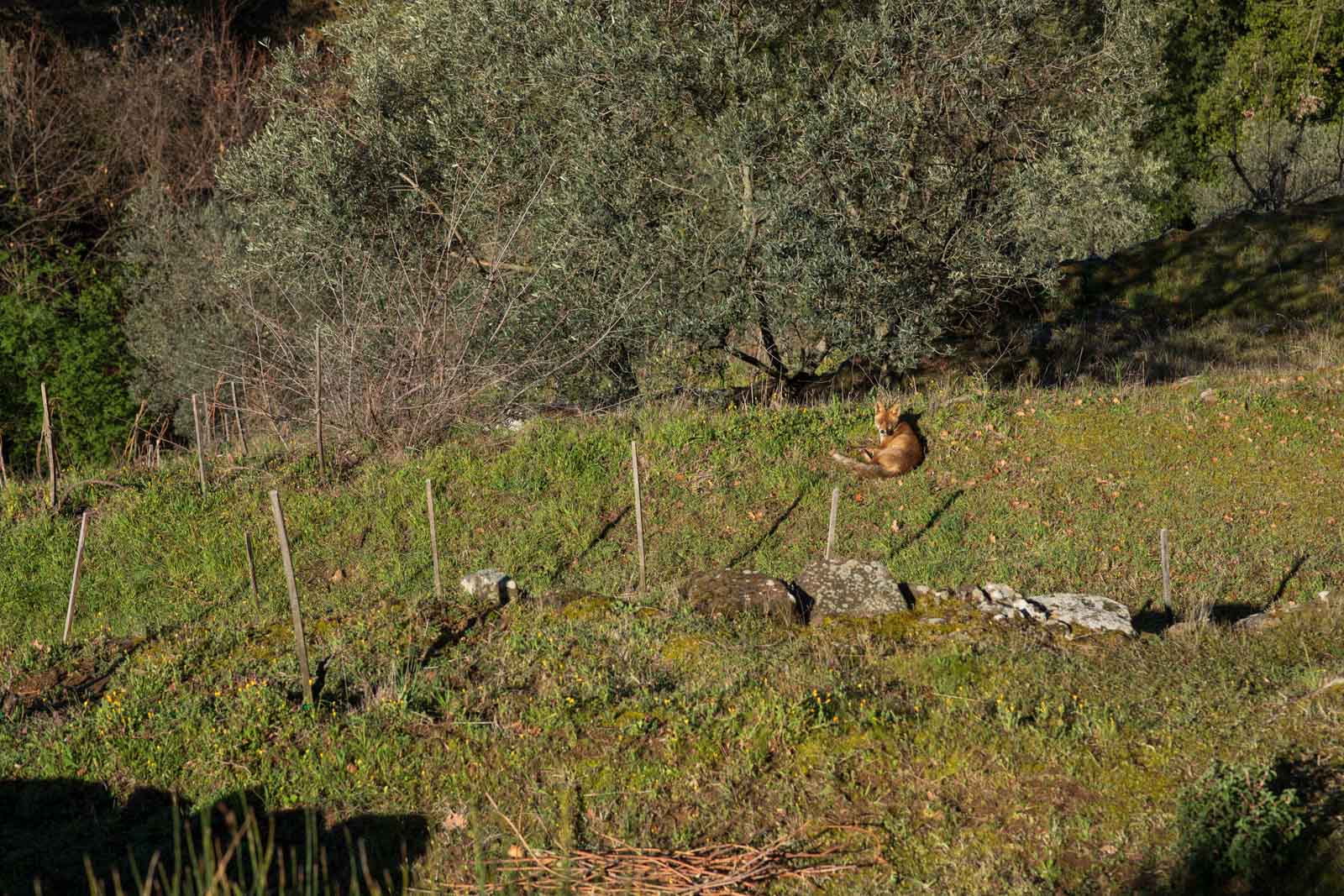
Brunello with Personality
The L’Aietta vineyard is 2.5 hectares in size, meaning it can only yield enough wine for roughly 30% of Mulinari’s annual Brunello di Montalcino. He also owns vines in nearby Castelnuovo dell’Abate — the southeastern portion of the appellation — and there, his other vineyards supply grapes for the rest of his Brunello as well as his Rosso di Montalcino and a quaffable, short-lees aged sparkling Sangiovese that kicked off our tasting. He also produces a few experimental wines in small supply. (“This is my game,” he said, pouring a melon-like, sweet-smelling yet flinty and dry bianco called “Grandine”).
Mulinari is also in the process of building a more suitable winery at that site, complete with rooms for fermentation, aging, bottling, labeling and hosting guests for tastings. He has come to the conclusion that the small, garage-sized facility at L’Aietta — while in close proximity to the vines at harvest — has a key drawback: because of the steep and rough road in, he can only install light-weight fermentation vessels — in other words, stainless steel. He wants to move entirely to concrete tanks to avoid stainless steel’s electromagnetic charge, which he thinks has an adverse effect on the wine’s fermentation process.
Once that move is complete, he might convert L’Aietta’s mini winery into a guest house for tourists, musing that the sunsets alone would sell it.
“A place for making a child,” he laughed.
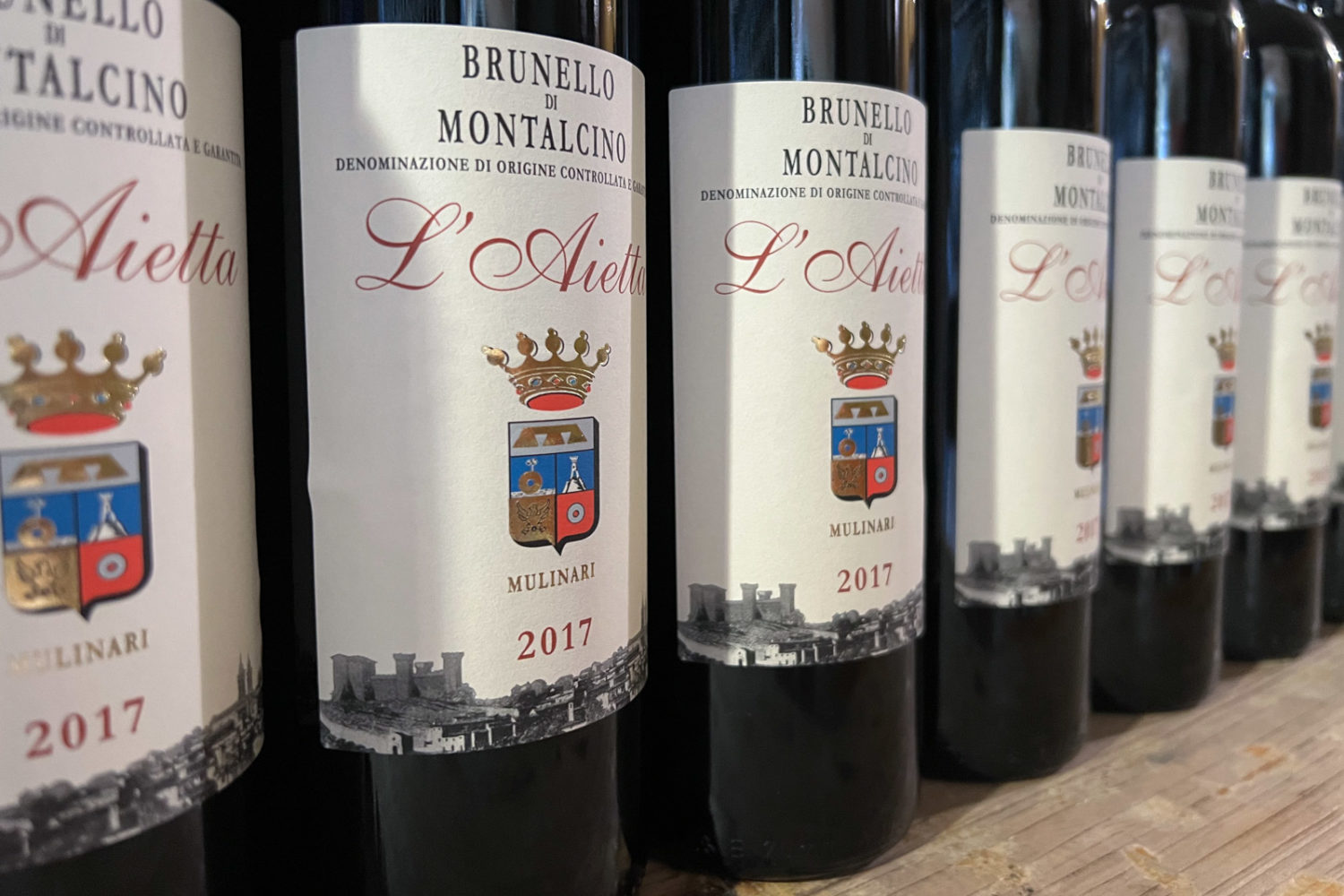
Outside the tiny winery’s door, Mulinari pulled the cork on his 2020 L’Aietta Rosso di Montalcino (★★★★ 3/4). Its fruit hails from the Castelnuovo dell’Abate vineyard, where the tannins are softer than fruit from L’Aietta. The wine had an inviting feel of raspberry-like fruit and orange peel as well as a playful acidity. We marveled at the radiant color in the morning light.
“L’Aietta is me. It is my son, my daughter. It is my heart. I breathe L’Aietta.”
Francesco Mulinari
Winemaker, L’Aietta
Next, he poured a glass of the 2017 Brunello di Montalcino (★★★★★) from L’Aietta, the vintage that garnered critical acclaim. Immediately, it registered as denser and more compact on the palate, as Brunello should be versus its counterpart Rosso. But Adam and I were both struck by its readiness: it seemed like a wine well on its way to maturity and integration. Brunello is a wine that typically requires time and ample bottle aging, yet the 2017 L’Aietta was revealing its individual personality already — a profusion of flavors reminiscent of red berries, grapefruit citrus and tanned leather. The cotton-like tannins were intense, but by no means overbearing. Most importantly, it was a unique version of Brunello without losing its Brunello identity. In a DOCG increasingly plagued by sameness, this alone validated Mulinari’s labor.
As good as the 2017 vintage was for him, Mulinari wanted to talk about the 2019 that was still in barrel. “I don’t make Riserva because I have too few of a quantity,” he told us. “But in 2019, when I saw the chemistry analysis of 100% L’Aietta, I said, ‘ok, I’ll make a Riserva,’ but only 300 bottles.”
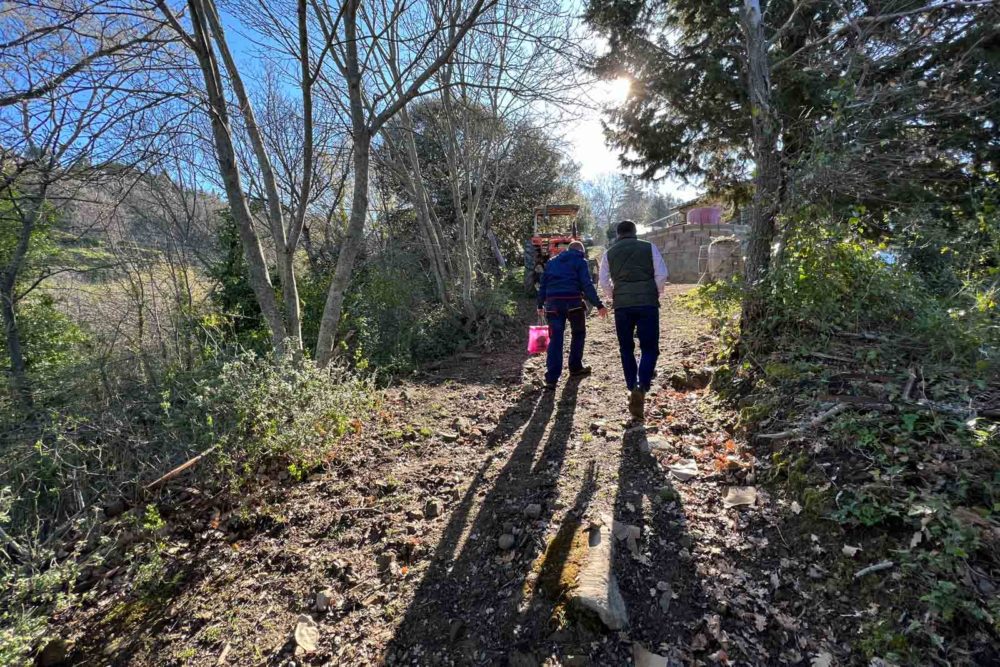
He pulled a barrel sample of the 2019 (★★★★★) for us — our one pure taste of the L’Aietta vineyard. It was a precious splash of that forthcoming Riserva. While certainly nascent and in need of some settling, it showed a level of purity that impressed me — it was supple and light, yet impactful and enticing. A Brunello on its toes. And it made me ponder whether, at a prospective 300 bottles, it would be the rarest wine I’d ever taste. (What was scarcer? The 2019 L’Aietta Riserva or that unlikely taste I got from the barrel of 2016 Grand Cru Romanée-Conti?).
There is No Secret
How does Mulinari makes all of this work? I wondered. It felt like a shoestring operation, yet he clearly had the poise and talent and diligence to be considered one of Montalcino’s “rising stars.” (And I say that in quotes because he is 20 years into his career. He admitted that he is still constantly learning about his vines and his craft … such is the slog of a winemaker’s career).
As we wrapped up, Mulinari grew serious for a moment. He wanted to make sure I understood something.
“L’Aietta is me,” he said. “It is my son, my daughter. It is my heart. I breathe L’Aietta.”
That answered my question as well as any words could.
